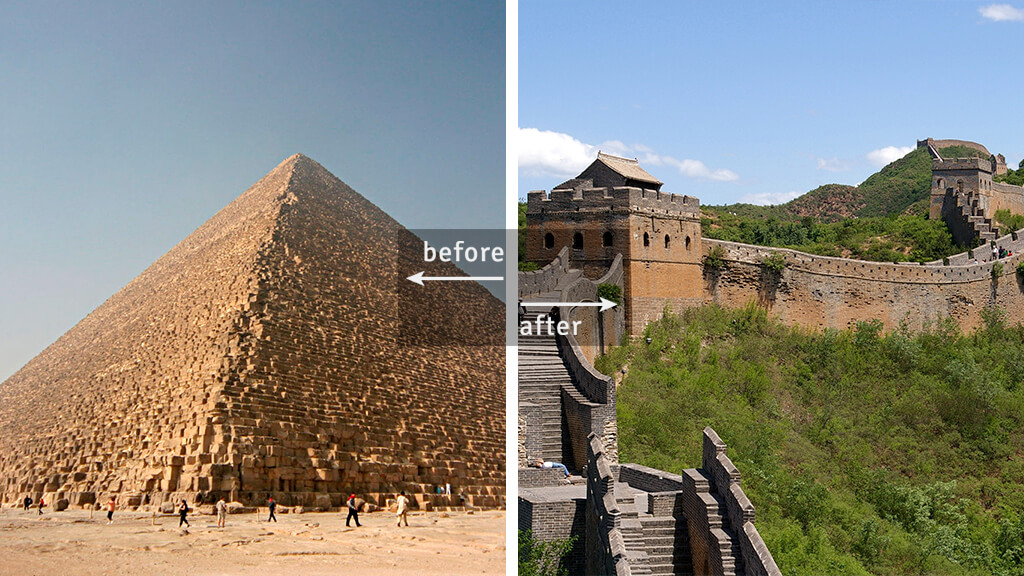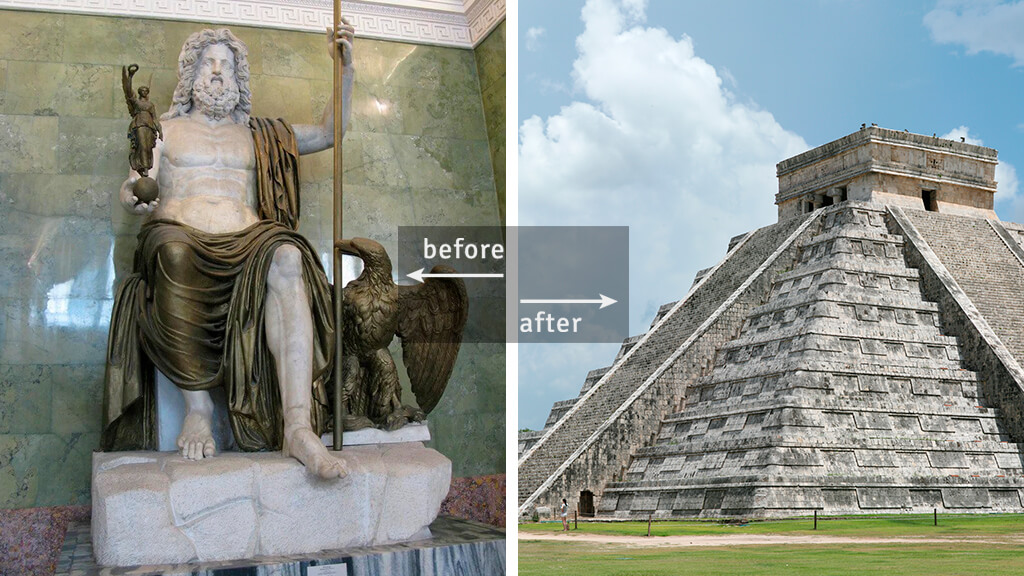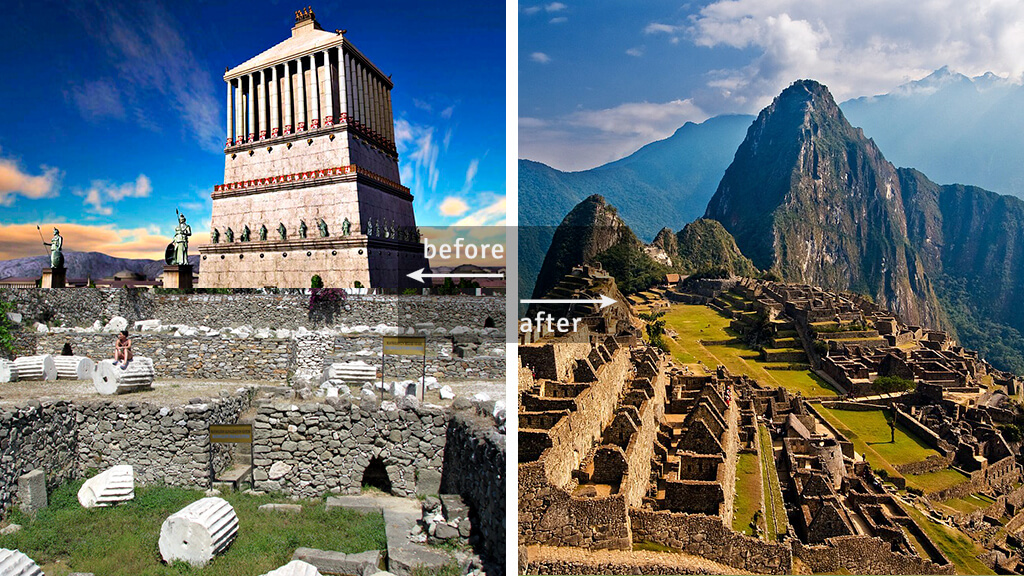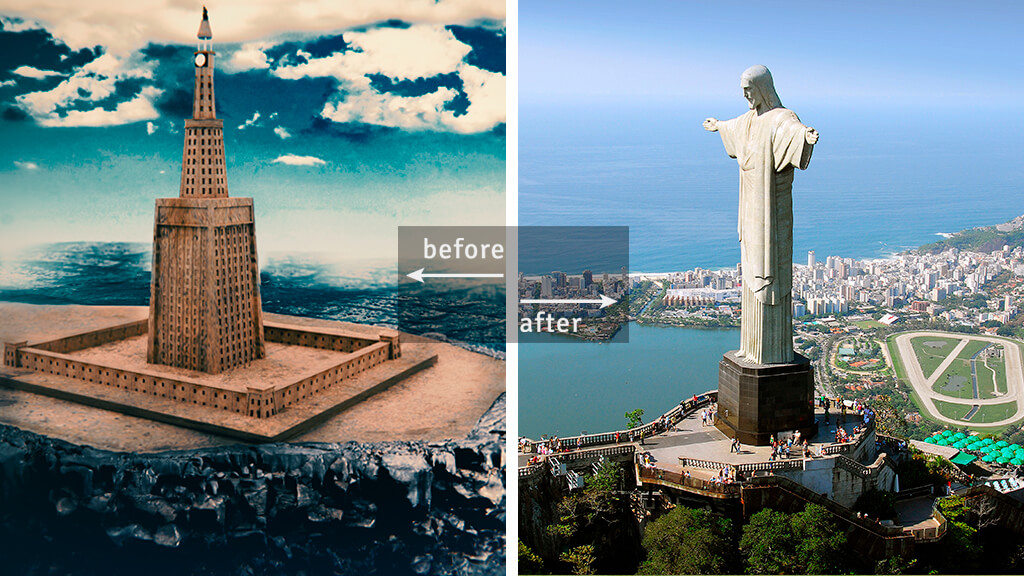Seven Wonders of the World – The Ancient & The New
Seven Wonders of the World is a list of remarkable constructions in human history. The list has always been popular among tourists. Every year, billions of tourists stand in the long lines, rain or shine, travel thousands of miles to visit one of the Seven Wonders.
before
Seven Wonders of the Ancient World
First such lists of the Seven Wonders date back to the 2nd century B.C. They are mentioned in guidebooks and poems of ancient Hellenic authors. The list in its current form, was stabilized at the beginning of Renaissance and contains only sculptural and architectural monuments of the Mediterranean and Middle Eastern regions. Only one worder – the Great Pyramid of Giza, oldest of the ancient wonders has survived to our days. The Colossus of Rhodes, the Lighthouse of Alexandria, the Mausoleum at Halicarnassus, the Temple of Artemis and the Statue of Zeus were destroyed.
after
New Seven Wonders
The Swiss corporation New7Wonders Foundation started a campaign in 2000 to choose the New Seven Wonders from a selection of 200 existing monuments through online votes. The winners were announced in 2007 from 21 shorlisted candidates and the list of winners didn’t include the Great Pyramid of Giza. It was added to the list as an honorary candidate.
Let’s see the old and new list of Seven Wonders of the World side by side.
1. Great Pyramid of Giza / Great Wall of China
before
Great Pyramid of Giza
The Great Pyramid of Giza, also known as the Pyramid of Khufu or the Pyramid of Cheops, is the oldest and largest of the pyramids in the Giza, Greater Cairo, Egypt. It is the oldest of the Seven Wonders of the Ancient World, and the only one to remain largely intact. The Great Pyramid has been determined to be about 4600 years old. Its initial height was 481 feet (now 454.4 feet) and was the tallest man-made structure in the world for more than 3,800 years. It was finally outdone by Lincoln Cathedral in the 1300s. It required 2.5 million stone blocks ranging from 2 to over 50 tons to be cut, moved and positioned. How the Pyramids at Giza were built is one of Egypt’s biggest mysteries. As to the question of how over two million blocks could have been cut within Khufu’s lifetime, an archaeological experiment was carried out in 2017, which concluded that about 3,500 quarry-men could have produced the 250 blocks/day needed to complete the Great Pyramid in 27 years.

Credit: Nina Aldin Thune / Jakub Hałun
after
Great Wall of China
The Great Wall of China is the largest man-made project in the world. It is a series of walls and fortifications located in northern border of China. In total 13.000 miles in length, it was built as protection against various nomadic groups from the Eurasian Steppe. Several walls were built from as early as the 7th century BC, with selective stretches later joined together by the first emperor of China Qin Shi Huang in the 3rd century B.C. Later on, many successive dynasties built and maintained multiple stretches of border walls. Most of today’s relics are the Ming Dynasty Great Wall: length 5,500 miles. In December 1987 the Great Wall was placed on the World Heritage List by UNESCO.
The notion that the wall can be seen from the moon (with an average orbital radius of 239,000 miles) is a well-known but untrue myth. Whether the wall is visible from low Earth orbit (an altitude of as little as 100 miles), NASA claims that it is barely visible, and only under nearly perfect conditions; it is no more conspicuous than many other man-made objects.
2. Hanging Gardens of Babylon / Petra
before
Hanging Gardens of Babylon
Hanging Gardens of Babylon were described as cascades of gardens containing a wide variety of trees, shrubs, and vines, constructed of mud bricks. They were thought to be the work either of the queen Sammu-ramat (Greek Semiramis, mother of the Assyrian king Adad-nirari III, 8th century B.C.) or of King Nebuchadrezzar II (6th century B.C.), who built them to console his Median wife, Amytis, because she missed the mountains and greenery of her homeland. The Hanging Gardens are the only one of the Seven Wonders for which the location has not been definitively established, it was said to have been built in the ancient city of Babylon, near present-day Hillah, Babil province, in Iraq. There are no extant Babylonian texts that mention the gardens, and no definitive archaeological evidence has been found in Babylon.

Credit: Diego Delso
after
Petra
Petra is an ancient city, centre of an Arab kingdom in Hellenistic and Roman times, the ruins of which are in southwest Jordan. It was a thriving trading center and the capital of the Nabataean empire between 400 B.C. and A.D. 106. Carved directly into vibrant red, white, pink, and sandstone cliff faces, the prehistoric Jordanian city of Petra was “lost” to the Western world for hundreds of years. The city sat empty and in near ruin for centuries. Only in the early 1800s did a European traveler disguise himself in Bedouin costume and infiltrate the mysterious locale. In 1985, the Petra Archaeological Park was declared a UNESCO World Heritage site.
Several scenes from the Hollywood blockbuster Indiana Jones and the Last Crusade were filmed in Petra.
3. Temple of Artemis / Colosseum
before
Temple of Artemis
The Temple of Artemis also known as the Temple of Diana, was a Greek temple dedicated to goddess Artemis. It was located in Ephesus (near the modern town of Selçuk, Turkey). Built in 6th century B.C., it was a huge building, over 350 by 180 feet, double the dimensions of other Greek temples including the Parthenon. In 356 B.C., the temple burned down. Various sources describe this as a vainglorious act of arson by a man, Herostratus, who set fire to the wooden roof-beams, seeking fame at any cost; thus the term herostratic fame. For this outrage, the Ephesians sentenced the perpetrator to death and forbade anyone from mentioning his name; but Theopompus later noted it. The temple was rebuilt after more then 30 years, to be destroyed or damaged again in 268 A.D. by the Goths and finally ruined in 401 A.D. Only foundations and fragments of the last temple remain at the site.

Credit: Zee Prime / FDV / FeaturedPics
after
Colosseum
The Colosseum is a giant oval amphitheatre in the centre of the city of Rome, Italy, built during the Romanian Empire. It is the largest ancient amphitheatre ever built, and is still the largest standing amphitheatre in the world. The construction of the Colosseum began in the year 72 under the empire of Vespasian and was finished in the year 80 during the rule of his first son emperor Titus and the further modifications were made during the reign of his second son Domitian (81–96). The Colosseum could hold an estimated 50,000 to 80,000 spectators. It was used for gladiatorial contests and public spectacles including animal hunts, executions, re-enactments of famous battles, and dramas based on Roman mythology, and briefly mock sea battles.
Although substantially ruined because of earthquakes and stone-robbers, the Colosseum is the main symbol of Rome and one of the greatest tourist attractions. The Colosseum is also depicted on the Italian version of the five-cent euro coin.
4. Statue of Zeus at Olympia / Chichén Itzá
before
Statue of Zeus at Olympia
Statue of Zeus, at Olympia, Greece, was a 40 feet high statue made of ivory and gold. The statue was one of two masterpieces made by the Greek sculptor Phidias (the second was statue of Athena in the Parthenon) around 435 BC. It was placed in the huge Temple of Zeus at Olympia in western Greece. Zeus is the sky and thunder god in ancient Greek religion, who rules as king of the gods of Mount Olympus. The statue is made of ivory plates and gold panels on a wooden framework.
The circumstances of the statue’s eventual destruction are unknown. The 11th-century Byzantine historian Georgios Kedrenos records a tradition that it was carried off to Constantinople, where it was destroyed in the great fire of the Palace of Lausus, in 475 A.D.

Credit: Daniel Schwen
after
Chichén Itzá
Chichen Itza, ruined ancient Maya city occupying an area of 4 square miles in south-central Yucatán state, Mexico, was built approximately in 600 A.D. Throughout its nearly 1,000-year history, the city may have had the most diverse population in the Maya world. The site contains many fine stone buildings in various states of preservation, and many have been restored. The buildings were connected by a dense network of paved causeways, called sacbeob (Eng. white way). Many of these stone buildings were originally painted in red, green, blue and purple colors. The best known and voted as one of New Seven Wonders of the World is Temple of Kukulcán (El Castillo). It’s a step-pyramid consisting of a series of square terraces with stairways up each of the four sides to the temple on top. Sculptures of plumed serpents run down the sides of the northern balustrade. During the spring and autumn equinoxes, the late afternoon sun strikes off the northwest corner of the pyramid and casts a series of triangular shadows against the northwest balustrade, creating the illusion of a feathered serpent “crawling” down the pyramid
5. Mausoleum at Halicarnassus / Machu Picchu
before
Mausoleum at Halicarnassus
The Mausoleum at Halicarnassus built between 353 and 350 BC in Halicarnassus (present Bodrum, Turkey). The monument was the tomb of Mausolus, the ruler of Carnia. The tomb was approximately 148 ft in height with the four sides adorned with sculptural reliefs. It is likely that Mausolus started to plan the tomb before his death, as part of the building works in Halicarnassus, so that when he died, Artemisia II, his sister-widow, continued the building project. Artemisia spared no expense in building the tomb. She sent messengers to Greece to find the most talented artists of the time. These included Scopas, the man who had supervised the rebuilding of the Temple of Artemis at Ephesus. The famous sculptors were Leochares, Bryaxis, Scopas, and Timotheus, as well as hundreds of other craftsmen. The Mausoleum at Halicarnassus was destroyed by successive earthquakes from the 12th to the 15th century, the last surviving of the six destroyed wonders.
The word mausoleum has now come to be used generically for an above-ground tomb.

Credit:Rob / Pedro Szekely
after
Machu Picchu
Machu Picchu is a 15th-century Inca citadel located in the Eastern Cordillera of southern Peru, 50 miles northwest of Cuzco, on a 7,970 ft mountain ridge. Machu Picchu was built in the classical Inca style, with polished dry-stone walls. Its three primary structures are the Intihuatana, the Temple of the Sun, and the Room of the Three Windows. The Incas, in contrast with the Mayans, had no written language, and no European visited the site until the 19th century, so far as is known. There are, therefore, no written records of the site while it was in use. The names of the buildings, their supposed uses, and their inhabitants are all the product of modern archeologists, on the basis of physical evidence, including tombs at the site. Most of the outlying buildings have been reconstructed in order to give visitors a better idea of how they originally appeared. By 1976, 30% of Machu Picchu had been restored and restoration continues. Machu Picchu was declared a UNESCO World Heritage Site in 1983.
In the Quechua language, machu means “old” or “old person”, while pikchu means either “portion of coca being crunched” or “pyramid, pointed multi-sided solid; cone”. Thus the name of the site is sometimes interpreted as “old mountain”.
6. Colossus of Rhodes / Taj Mahal
before
Colossus of Rhodes
The Colossus of Rhodes was a statue of the Greek sun-god Helios, erected in the city of Rhodes, built to thank the gods for the victory over Demetrius Poliorcetes’ long siege (305 BCE) of Rhodes. It had 108 feet in height (approximately the height of the modern Statue of Liberty from feet to crown) making it the tallest statue in the ancient world. It collapsed during the earthquake of 226 BC, although parts of it were preserved until 653, when Arabian forces raided Rhodes and had the statue completely destroyed and the remains sold.

after
Taj Mahal
The Taj Mahal is an ivory-white marble mausoleum on the right bank of the river Yamuna in Agra, western Uttar Pradesh state, northern India. The Taj Mahal was commissioned in 1632 by the Mughal emperor Shah Jahan (reigned 1628–58) to immortalize his wife Mumtaz Mahal, who died in childbirth in 1631, having been the emperor’s inseparable companion since their marriage in 1612. The mausoleum houses the tombs of both Mumtaz Mahal and Shah Jahan himself.
The Taj Mahal, construction of the 42-acre (17-hectare), had been completed in its entirety in 1653 at a cost estimated at the time to be around ₹32 million, which in 2020 would be approximately ₹70 billion (about U.S. $1 billion). The Taj Mahal was designated as a UNESCO World Heritage Site in 1983.
7. Lighthouse of Alexandria / Christ the Redeemer
before
Lighthouse of Alexandria
The lighthouse of Alexandria, also called Pharos of Alexandria was the most famous lighthouse in antiquity. It has been estimated to have been at least 330 ft in overall height and for many centuries it was one of the tallest man-made structures in the world. Built by Sostratus of Cnidus, perhaps for Ptolemy I Soter, it was finished during the reign of Soter’s son Ptolemy II of Egypt in about 280 B.C. The lighthouse was severely damaged by three earthquakes between 956 and 1323 AD and became an abandoned ruin. It was the third-longest surviving ancient wonder (after the Mausoleum at Halicarnassus and the extant Great Pyramid of Giza), surviving in part until 1480, when the last of its remnant stones were used to build the Citadel of Qaitbay on the site. In 1994, a team of French archaeologists dove into the water of Alexandria’s Eastern Harbour and discovered some remains of the lighthouse on the sea floor. In 2016 the Ministry of State of Antiquities in Egypt had plans to turn submerged ruins of ancient Alexandria, including those of the Pharos, into an underwater museum.

Credit: Freddy2400 / sfmthd/Fotolia
after
Christ the Redeemer
Christ the Redeemer is an Art Deco statue of Jesus Christ in Rio de Janeiro, Brazil. Constructed between 1922 and 1931, the statue is 98 ft high, excluding its 26 ft pedestal. The arms stretch 92 ft wide. It is made of reinforced concrete and soapstone. The statue is located at the peak of the 2,300 ft Corcovado mountain in the Tijuca National Park overlooking the city of Rio de Janeiro.
Sources: Wikipedia, Britannica, NatGeo, New7Wonders


